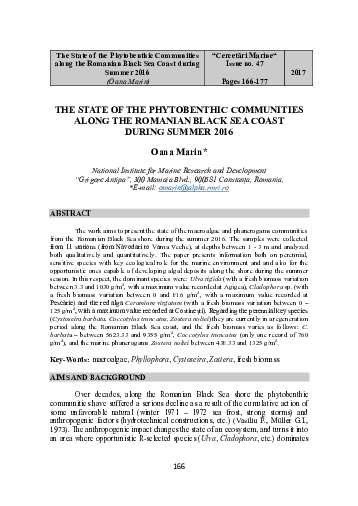The State of the Phytobenthic Communities along the Romanian Black Sea Coast during Summer 2016
DOI:
https://doi.org/10.55268/CM.2017.47.166Keywords:
macroalgae, Phyllophora, Cystoseira, Zostera, fresh biomassAbstract
The work aims to present the state of the macroalgae and phanerogams communities from the Romanian Black Sea shore during the summer 2016. The samples were collected from 11 stations (from Năvodari to Vama Veche), at depths between 1 - 3 m and analyzed both qualitatively and quantitatively. The paper presents information both on perennial, sensitive species with key ecological role for the marine environment and and also for the opportunistic ones capable of developing algal deposits along the shore during the summer season. In this respect, the dominant species were: Ulva rigida (with a fresh biomass variation between 3.3 and 1030 g/m2 , with a maximum value recorded at Agigea), Cladophora sp. (with a fresh biomass variation between 0 and 816 g/m2 , with a maximum value recorded at Pescărie) and the red alga Ceramium virgatum (with a fresh biomass variation between 0 – 125 g/m2 , with a maximum value recorded at Costinești). Regarding the perennial key species (Cystoseira barbata, Coccotylus truncatus, Zostera noltei) they are currently in a regeneration period along the Romanian Black Sea coast, and the fresh biomass varies as follows: C. barbata – between 5623.33 and 9355 g/m2 , Coccotylus truncatus (only one record of 760 g/m2 ), and the marine phanerogams Zostera noltei between 438.33 and 1325 g/m2.
Downloads
Published
2017-12-02
How to Cite
Marin, O. (2017). The State of the Phytobenthic Communities
along the Romanian Black Sea Coast during
Summer 2016. Cercetări Marine - Recherches Marines, 47(1), 166–177. https://doi.org/10.55268/CM.2017.47.166
Issue
Section
ORIGINAL ARTICLES
License
This is an open access journal, which means that all content is freely available without charge to the user or his/her institution. Users are allowed to read, download, copy, distribute, print, search, or link to the full texts of the articles, or use them for any other lawful purpose, without asking prior permission from the publisher or the author. This is in accordance with the BOAI definition of open access.






